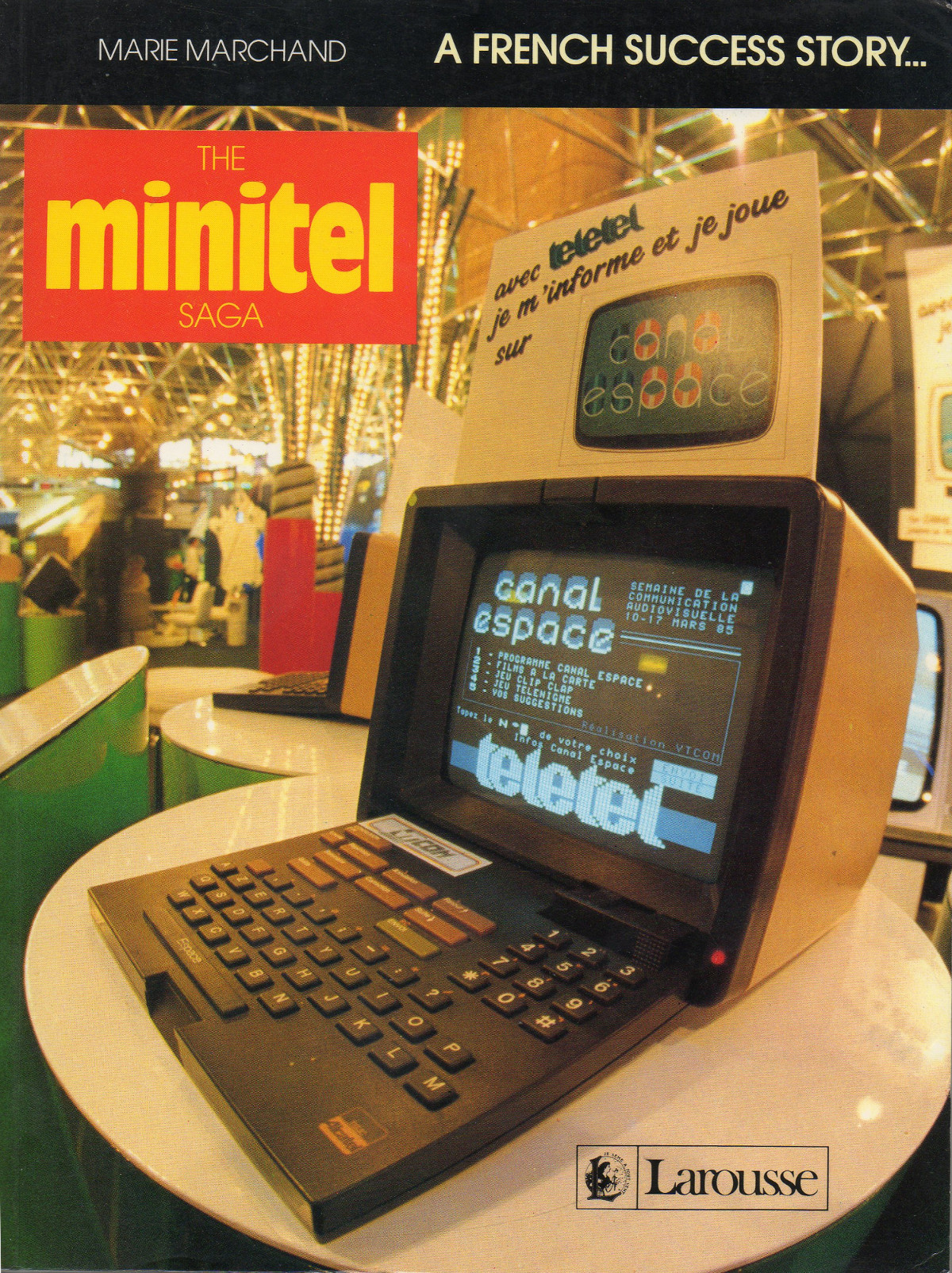Marie Marchand: The Minitel Saga: A French Success Story (1988)
Filed under book | Tags: · computing, france, networks, technology, telephone, video, virtual communities

The only English-language monograph on the popular Videotex online service Minitel, which operated in France between 1978-2012.
“Minitel was proposed and adopted in 1978, the same year that Simon Nora and Alain Minc submitted their influential report The Computerization of Society in which they coined the term ‘telematics’. Minitel also came on the heels of a “phone-in-every-home” program (pre-dating the One Laptop Per Child project by many decades) that was proposed in 1975 by then-general manager of France Telecom Gérard Théry to increase subscriber telephone lines; Théry firmly believed the telephone was going to be the cornerstone of any computerized country – “A phone in every home is the cutting edge of a computer in every home.” Just three years later in 1978, 2500 people in the Parisian suburb of Vélizy had volunteered to use the system initially called “Teletel.” Marie Marchand tellingly writes in The Minitel Saga: A French Success Story that while “households used the system six times a month on average, consulting 20-odd services for a total connect time of one-and-a-half hours per month…”, “These overall figures concealed a number of pronounced disparities…Age disparity: people under 30 used their terminals more than those over 30. Gender disparity: women used them but little. Class disparity: top executives connected more often than midle management types, who in turn called more often than blue collar workers. Further, a flagrant disparity emerged in terms of services used. Five service providers alone accounted for over half the calls…” (53)
In 1982, instead of delivering increasingly expensive and difficult to update telephone book directories, France Telecom loaned Minitel terminals to residents all across France. By 1988, 3.5 million Minitel sets had been installed with users logging six million hours per month and taking advantage of 8000 services. And by 1999, roughly 9 million terminals could access to the network in turn used by 25 million people who took advantage of 26,000 services. By this time, not only had Minitel inaugurated an era that continues today of disparities between visible and invisible (or even absent) users based on gender, race, sexuality, and socio-economic status, but it also inaugurated the era of online pornography, the use of networks to coordinate student protests, and experiments with pseudonymous online identity.” (Lori Emerson)
Translated and adapted from the French by Mark Murphy
Publisher Larousse, Paris, 1988
ISBN 2035182409, 9782035182401
197 pages
via Lori Emerson
Resources: Minitel.org, Minitel Research Lab.
Comment (0)Luciana Parisi: Contagious Architecture: Computation, Aesthetics, and Space (2013)
Filed under book | Tags: · abstraction, aesthetics, algorithm, architecture, cognition, computation, computing, cybernetics, design, evolution, feedback, infinity, information, interaction design, knowledge, media, metaphysics, networks, neural networks, philosophy, processing, randomness, sensors, software, space, temporality, time, topology, variation

“In Contagious Architecture, Luciana Parisi offers a philosophical inquiry into the status of the algorithm in architectural and interaction design. Her thesis is that algorithmic computation is not simply an abstract mathematical tool but constitutes a mode of thought in its own right, in that its operation extends into forms of abstraction that lie beyond direct human cognition and control. These include modes of infinity, contingency, and indeterminacy, as well as incomputable quantities underlying the iterative process of algorithmic processing.
The main philosophical source for the project is Alfred North Whitehead, whose process philosophy is specifically designed to provide a vocabulary for “modes of thought” exhibiting various degrees of autonomy from human agency even as they are mobilized by it. Because algorithmic processing lies at the heart of the design practices now reshaping our world—from the physical spaces of our built environment to the networked spaces of digital culture—the nature of algorithmic thought is a topic of pressing importance that reraises questions of control and, ultimately, power. Contagious Architecture revisits cybernetic theories of control and information theory’s notion of the incomputable in light of this rethinking of the role of algorithmic thought. Informed by recent debates in political and cultural theory around the changing landscape of power, it links the nature of abstraction to a new theory of power adequate to the complexities of the digital world.”
Publisher MIT Press, 2013
Technologies of Lived Abstraction series
ISBN 0262018632, 9780262018630
392 pages
For a New Computational Aesthetics: Algorithmic Environments as Actual Objects lecture by Parisi (2012, video, 72 min).
Reviews: Lecomte (Mute, 2013), Ikoniadou (Computational Culture, 2014).
PDF (24 MB, updated o 2021-10-28)
Comments (2)Computational Culture, a Journal of Software Studies, Issue Four (2014)
Filed under journal | Tags: · computing, database, facebook, filesharing, networks, social media, software, software studies
“What marks much of the work presented in this issue of Computational Culture is its endeavour to pay more analytically precise attention to socio-technical formatting of the present, based on a common assumption that the specificities of computational forms are fundamentally constitutive of that present.” (from the Editorial)
With articles by Paul Dourish, Irina Kaldrack and Theo Röhle, Benjamin Grosser, Dennis Tenen and Maxwell Foxman, Alex Taylor, Jasmin Fisher, Byron Cook, Samin Ishtiaq; comments by Geert Lovink, Mark Marino; and a review section.
Editorial group: Matthew Fuller, Andrew Goffey, Olga Goriunova, Graham Harwood, Adrian Mackenzie
Published in November 2014
Open Access
ISSN 2047-2390

